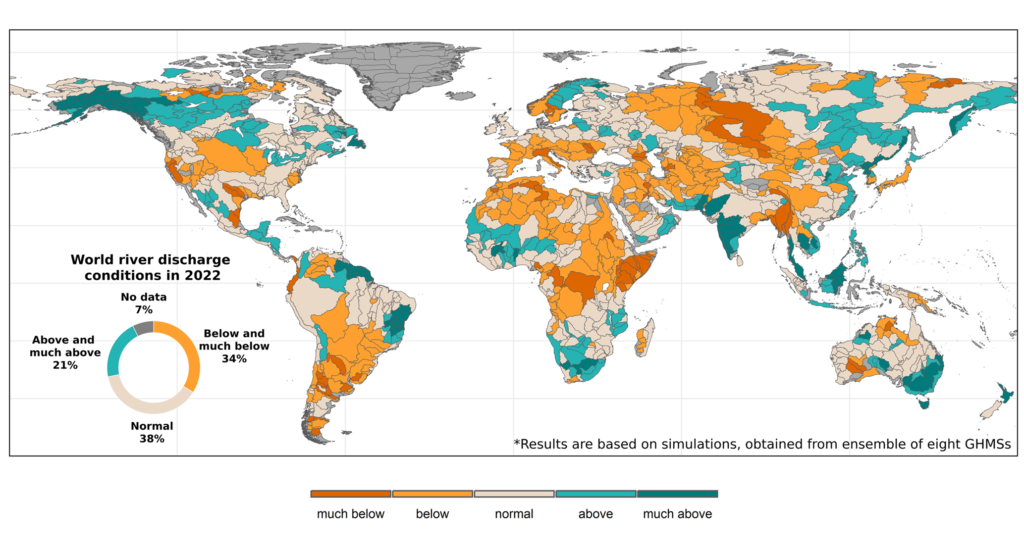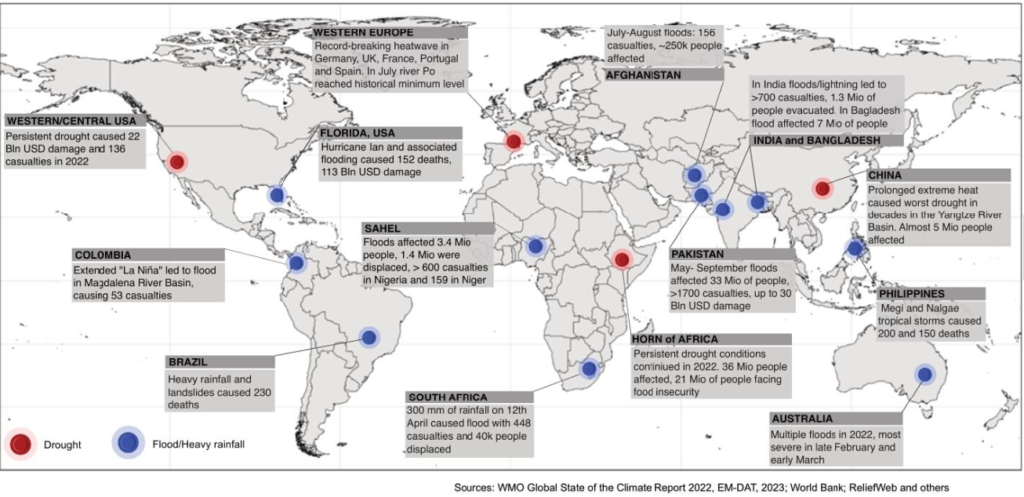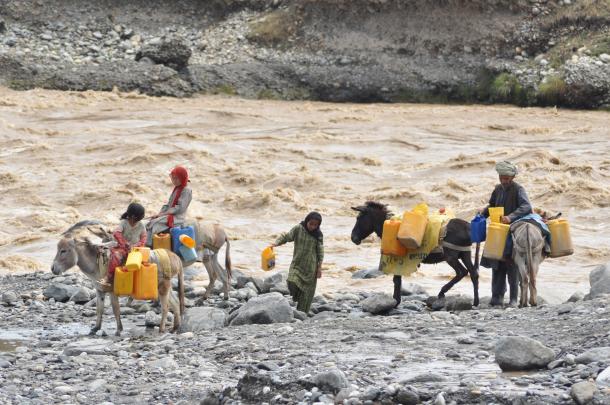According to a new report from the World Meteorological Organization (WMO), the hydrological cycle is spinning out of balance as a result of climate change and human activities.
The WMO State of Global Water Resources Report 2022 builds on a pilot issued in 2022. It contains more expanded information on important hydrological variables like groundwater, evaporation, streamflow, terrestrial water storage, soil moisture, cryosphere (frozen water), inflows to reservoirs and hydrological disasters. It integrates field observations, satellite-based remote sensing data and numerical modeling simulations to assess water resources at the global scale.
“This WMO report offers a comprehensive and consistent overview of water resources worldwide, highlighting the influence of climate, environmental and societal changes,” said WMO Secretary-General Prof. Petteri Taalas. “Glaciers and ice cover are retreating before our eyes. Rising temperatures have accelerated – and also disrupted – the water cycle. A warmer atmosphere holds more moisture. We are seeing much heavier precipitation episodes and flooding. And at the opposite extreme, more evaporation, dry soils and more intense droughts.”
He continued, “The overwhelming majority of disasters are water-related and so water management and monitoring lies at the heart of the global Early Warnings For All initiative. Many of the countries targeted for priority action in Early Warnings for All suffered from major floods or droughts in 2022. Not a single country had timely and accurate hydrological data available to support evidence-based decision making and early action. This report is a call to action for more data sharing to enable meaningful early warnings and for more coordinated and integrated water management policies that are an integral part of climate action.”
Key findings

Hydrological variables
The report provides a global-scale quantitative assessment of water resources in large river basins in comparison with the long-term average for various variables like river discharge, groundwater, evaporation, soil moisture, inflow to reservoirs, etc. In 2022, over 50% of the global catchment areas experienced deviations from normal river discharge conditions. Most of these areas were drier than normal, while a smaller percentage of basins displayed above or much above normal conditions. This was similar to 2021. More than 60% of major water reservoirs saw below-normal or normal inflow, which provides a challenge for providing water to all users in an increasingly variable climate.
Throughout 2022, anomalies in soil moisture and evaporation echoed those in river discharge conditions. Thus, for instance, Europe saw increased evaporation and decreased soil moisture and river flows during the summer because of a major heatwave and drought. This led not only to challenges in agriculture but also to a shutdown of power plants due to the lack of cooling water. The switch from La Niña in 2022 to El Niño conditions in 2023 will likely have a major impact on the hydrological cycle that will be analyzed in next year’s report.
Cryosphere
The Third Pole, encompassing the Tibetan Plateau, the Himalayas, the Karakorum, the Hindu Kush, the Pamirs and the Tien Shan Mountains, is vital for the water supply of almost two billion people. From 2000 to 2018, total glacier mass balance decreased by more than 4%. There has been a sizable decrease in snow cover and a big increase in the volume of glacial lakes. This has affected river runoffs at the Indus, Amu Darya, Yangtze and Yellow River basins, indicating the evolving influence of climate change on the region.
In 2022, the snow cover in the Alps, crucial for feeding major rivers like the Rhine, Danube, Rhone and Po, remained much lower than average. The European Alps witnessed unprecedented levels of glacier mass loss. The subtropical Andes experienced a consistent decline in winter snow accumulation since 2009, affecting water supplies for cities across Chile and the west of Argentina. Although 2022 saw slightly above-average snow in some areas, key watersheds still reported below-average conditions, especially on the Argentinian side, leading to sustained water restrictions in populous urban centers.
Water-related disasters
Severe droughts affected many parts of Europe in the summer of 2022, posing transportation challenges in rivers like the Danube and Rhine and disrupting nuclear electricity production in France due to the lack of cooling water. Navigation on the Mississippi River in the USA was affected by the extremely low water levels, as a result of a continuous drought in the USA.
In South America, the La Plata River basin has endured a continuation of drought conditions since 2020. This caused a significant drop in hydropower production in 2022 due to low river flows. There were several instances of no water supply in Paraguay during 2022.
Severe drought in the Yangtze River Basin in China led to much lower-than-average river discharge, inflow to reservoirs and soil moisture.
Prolonged drought led to a major humanitarian crisis in the Horn of Africa. By contrast, the Niger Basin and much of South Africa recorded above-average river discharge, linked to major flood events in 2022. A mega flood hit the Indus River Basin in Pakistan, killing at least 1,700, affecting 33 million and causing an estimated more than US$30bn in economic losses. A heatwave early in the year increased meltwater from glaciers, increasing river levels that were then swelled by severe monsoon rainfall that was more than twice the average in July and August.

WMO response
The report highlighted the lack of accessible verified hydrological data. Africa, the Middle East and Asia, in particular, have too little available observational data. There is an urgent need for investments in monitoring and data sharing in accordance with the WMO Unified Data Policy. The WMO Hydrological Status and Outlook System (HydroSOS), which is currently under development, seeks to meet this challenge.
Scope of the report
The 2022 edition of the Global State of the Water Resources Report has introduced several advancements. It incorporates new chapters, with additional components of the hydrological cycle: groundwater, soil moisture, evapotranspiration, snow and ice, and reservoir inflows. Data for these additional components was received through the integration of observation, satellite-based remote sensing data, and outputs from numerical modeling simulations.
There has been an increase in the amount of observed discharge data compared with the previous year, which was received from more than 500 stations. After quality control, this was reduced to 273 stations as compared with the 38 stations utilized in the previous report. However, data sharing was limited to only 14 countries, leaving regions such as Africa, the Middle East and Asia notably underrepresented in terms of available observational data.
The spatial resolution of global analysis has been refined, reaching a total of 986 river basins globally.
For more key WMO updates from the meteorological technology industry, click here.



